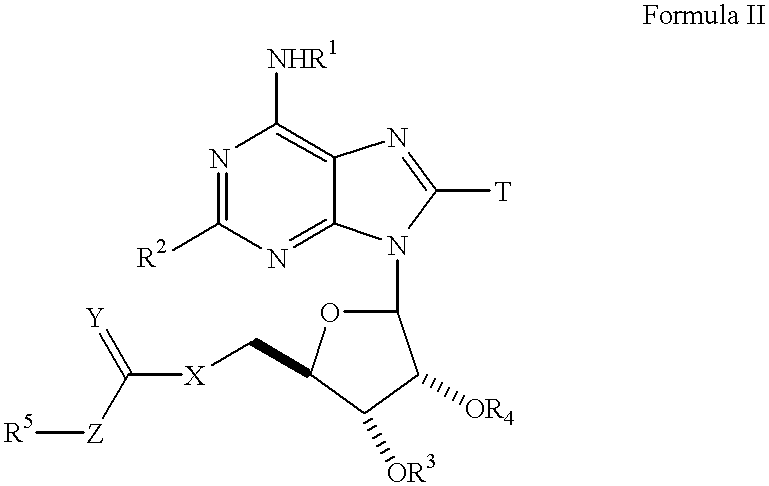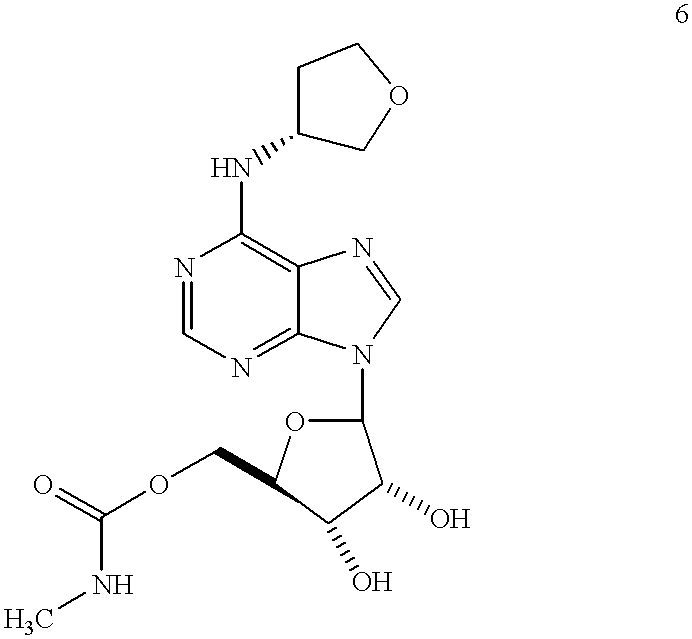Method of identifying partial adenosine A1 receptor agonists and their use in the treatment of arrhythmias
a technology of adenosine a1 receptor, which is applied in the field of identifying partial adenosine a1 receptor agonists and their use in the treatment of arrhythmias, can solve the problems of limited rate control treatment of adenosine, potential harmful effects, and significant limitations
- Summary
- Abstract
- Description
- Claims
- Application Information
AI Technical Summary
Benefits of technology
Problems solved by technology
Method used
Image
Examples
example 1
[0111] The following examples are biological assays used to evaluate compounds prepared in Examples 2-4 below.
[0112] Reagents: The A.sub.1-AdoR antagonists 8-cyclopentyl-1,3-dipropylxa-nthine (CPX) and 8-cyclopentyl-1,3-dimethylxanthine (CPT), the A.sub.1-AdoR agonists N.sup.6-cyclopentyladenosine (CPA), 2-chloro-N.sup.6-cyclopentyladenosine (CCPA), and N-cyclohexyladenosine (CHA), the adenosine deaminase inhibitor erythro-9-(2-hydroxy-3-nonyl)ade-nine (EHNA), the adenosine kinase inhibitor iodotubercidin, and forskolin were purchased from Research Biochemicals (Natick, Mass.). CVT-2759, [(5-{6-[((3R)oxolan-3-yl)amino]purin-9-yl}(3 S,2R,4R)-3,4-dihydroxyoxolan--2-yl)methoxy] -N-methylcarboxamide, molecular weight 394.38 was prepared as set forth in Example 2--Compound 6. Adenosine was purchased from Sigma Chemical Co. (St. Louis, Mo.). The radioligand 8-cyclopentyl-1,3-dipropyl--[2,3-.sup. 3H(N)]xanthine (.sup.3H-CPX) was purchased from New England Nuclear (Boston, Mass.). Concentra...
example 2
[0131] Preparation of compounds 6 and 7 starting from compound 3 is shown in the synthesis scheme below. Compound 3 was prepared from 6-chloropurineriboside 1 and 3 (R )-aminotetrahydrofuran following the procedure reported earlier (U.S. Pat. No. 5,789,416). Protection of the 2' and 3' hydroxy groups as an acetonide with 2,2-dimethoxypropane in the presence of TsOH(cat.) gave 4. Reaction of 4 with CDI in THF followed by treatment with 40% aq.methylamine gave carbamate 5. Deprotection of the 2',3' acetonide with 80% AcOH / water at 80-90 C. gave carbamate 6. Esterification of 6 with acetic anhydride in pyridine gave diester 7. 4
[(5-{6-[((3R)oxolan-3-yl)amino]purin-9-yl}(3S,2R,4R,5R)-3,4-dihydroxyoxola-n-2-yl)methoxy] -N-ethylcarboxamide (25)
[0132] This compound was prepared in a manner similar to that of 6, substituting ethyl amine for methyl amine: (M+1)=409.35
[(5-{6-[((3R)oxolan-3-yl)amino]purin-9-yl}(3S,2R.sup.4R,5R)-3,4-dihydroxyo-xolan-2-yl)methoxy] -N-propylcarboxamide (26)
[0133]...
example 3
[0217] The compounds of this example are prepared as outlined in Schemes 1-4, below. Compounds having the general formula IV can be prepared as shown in Scheme 1. Compound I can be prepared through reaction of the corresponding primary amino compound, R.sup.1NH.sub.2, through heating with commercially available 6-chloroadenosine in the appropriate solvent (eg. n-butanol, dimethylformamide, and ethanol). The primary amino compound, R.sup.1NH.sub.2, is either commercially available or can be prepared as previously described in U.S. Pat. No. 5,789,416, the specification of which is incorporated herein by reference. The pro-drug esters of this invention can be prepared using all of the known methods for ester formation which are included by reference (see Jerry March Organic synthesis and Richard Larock--Methods of Organic Synthesis), and more preferably by those outlined in this application. 16
[0218] The key intermediate compound III can be prepared by the direct chlorination of the 2'...
PUM
| Property | Measurement | Unit |
|---|---|---|
| Fraction | aaaaa | aaaaa |
| Molar density | aaaaa | aaaaa |
| Molar density | aaaaa | aaaaa |
Abstract
Description
Claims
Application Information
 Login to View More
Login to View More - R&D
- Intellectual Property
- Life Sciences
- Materials
- Tech Scout
- Unparalleled Data Quality
- Higher Quality Content
- 60% Fewer Hallucinations
Browse by: Latest US Patents, China's latest patents, Technical Efficacy Thesaurus, Application Domain, Technology Topic, Popular Technical Reports.
© 2025 PatSnap. All rights reserved.Legal|Privacy policy|Modern Slavery Act Transparency Statement|Sitemap|About US| Contact US: help@patsnap.com



